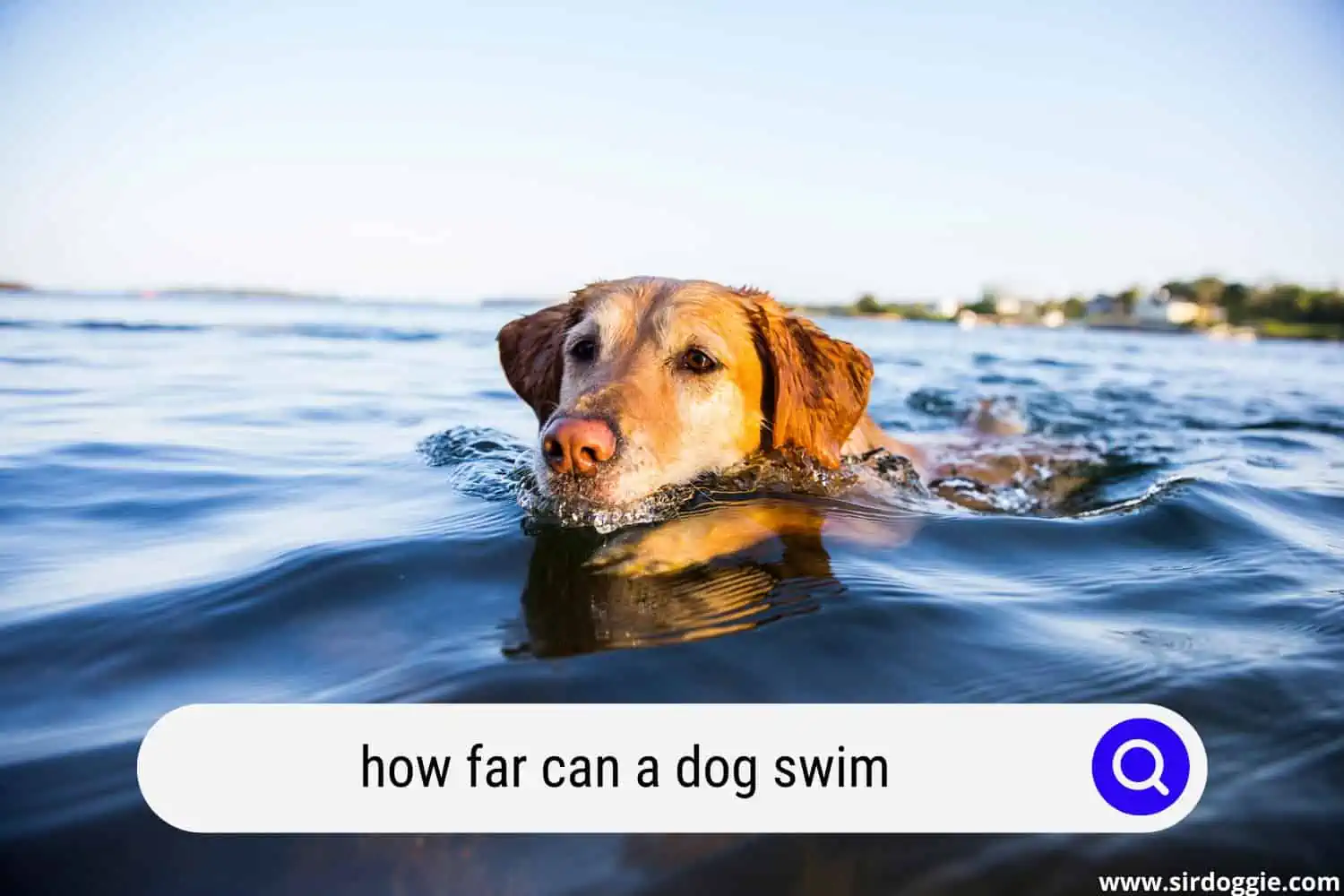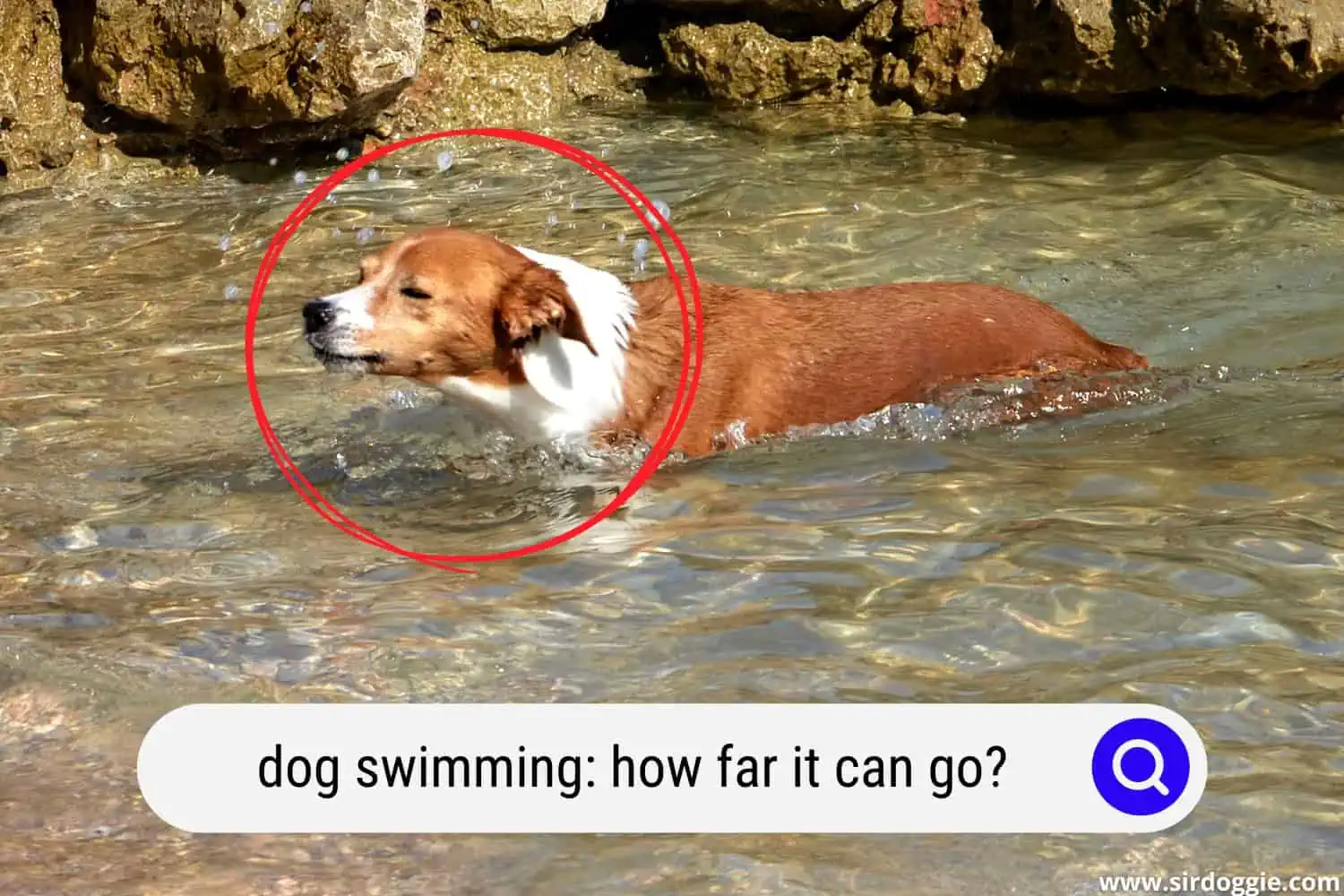How Far Can A Dog Swim (A Detailed Explanation)
Swimming is a wonderful healing and restorative activity for your dog. You should certainly plan to put in the time and energy required to teach your dog how to swim because swimming not only provides a chance to improve their health but can also have a greatly positive effect on the mental health of your pup as well as you, too.
Pet parents who take their dogs swimming are always concerned with the distance and duration of their pal’s swimming abilities, though. Let’s discuss that issue in detail so you know what to expect.

How Far Can A Dog Swim
Generally, dogs can swim around 100 yards or up to about 3 to 4 miles. On average, this means that they typically can swim for about 30 minutes on average at a time. However, a dog’s swimming capabilities are dependent upon its breed, stamina, age, size, the water temperature itself, and the overall general health of your canine friend.
Your dog’s swimming skills are significantly dependent upon his or her previous experiences involving physical activity. If they aren’t accustomed to working for extended periods on land or burning a lot of energy on a daily basis, they will most likely behave in the same manner in the water. Working dogs have better endurance, and this allows them to swim for longer periods of time compared to dogs who are lazier, calmer, or simply not built for the activity.
The Best Way to Teach a Pup to Swim
Swimming lessons for dogs are simple, and the swimming skill can be taught by following three steps:
Check to See If Your Pup is a Good Swimmer in the Water
The greatest place for your pet’s first swim is calm, shallow water. Ideally, the greatest swimming sites for pets are in bodies of water that don’t drop too deep too quickly, allowing the dog to roam around in the water at a comfortable height before starting to actually swim.
Keep in mind that most water can rapidly become deep enough to be above the heads of little dogs. Additionally, never force your dog to swim until you are certain that they are comfortable in the water. Never force a dog into the water; instead, let your pup make the decision of whether or not they actually want to swim.
Suit Up With Your Pet
When determining whether your dog is interested in swimming, get into the water yourself and urge him to join you. Take a few steps forward and watch whether your pet follows. If your canine follows you into the water and appears confident and content, they have a good chance of becoming a swimmer themselves.
On the other side, if your dog is afraid of getting wet, don’t force them to go swimming. If you scare your pet regarding submerging themselves into any bodies of water on their first try, they will never want to go swimming again.
Make It Enjoyable
You can encourage your dog to enter the water on their own when they have demonstrated that they enjoy swimming (and that they are skilled swimmers) by throwing a ball or other fun toy into the water.
Dogs who enjoy retrieving, in general, may find retrieving in the water to be just as thrilling as retrieving on land. Swimming and retrieving for fun are excellent forms of exercise for your pup.
Related Reading: Can Dogs Catch Fish? (A Detailed Explanation)
What is the Maximum Amount of Time a Dog Should Swim in the Ocean?
When it comes to swimming in the ocean, dogs can spend the same amount of time as they do in a pool or other bodies of water: about 20 to 40 minutes, depending upon their breed and other physical factors.
Why Swimming in the Ocean May Not Be Best for Your Dog
Although pools and ponds are notably safer options when it comes to your dog’s swimming locations, oceans represent significant dangers to your dog, such as the following:
Drinking Ocean Water Can Make Your Dog Sick
If your dog were to drink ocean water, this could cause him or her to become quite sick. The hazardous dose of salt for canines is around 3-4 grams per kilogram of body weight. A gallon of salt water contains about 18-22 teaspoons (105 grams) of sodium chloride (salt).
As a result, a gallon of seawater for a 12-pound canine can be hazardous to the dog’s health. Allow them to have access to plenty of clean, fresh water before swimming to prevent them from drinking from the sea intentionally, and make sure that you provide them with fresh water during any swimming breaks as well.
There are often Sharp Objects in the Sand
Shells and rocks can cause injuries to your dog’s paws if they are not careful. Marine debris, including the waste left behind by people, can be sharp enough to harm your dog if it gets into the water.
Some people believe that the high amount of salt in ocean water is beneficial in the healing of wounds. However, this is entirely false. The water that comes from the ocean can easily cause the wound to become inflamed due to the high amount of germs and waste, including bacteria that can spread infection to your dog.
Saltwater and Your Dog’s Skin
Salt water is a lot more harsh than the water your dog might swim in while in a pool, even though treated pool water often utilizes strong chemicals to maintain its cleanliness. However, both of these water conditions—both salt water as well as chemical-treated water—can result in your dog developing dry, flaky skin as well as fragile hair.
The effect of saltwater on a dog’s coat and skin is dependent upon their natural coat texture, though. Labrador Retrievers have a water-repellent double coat that prevents them from having their skin peeled away by the elements. For dogs with such water-resistant coats, the water will far be less likely to reach their skin, therefore they have a much lower risk of damage or irritation. For dogs that weren’t built for being in very much water very often, those dogs may find themselves with patches of fur loss due to the damage caused by saltwater.
See Also: Can Dogs Get Ear Infections From Swimming
Rip Currents
Rip currents are another potential threat when it comes to ocean water. When taking your pet for a swim in the ocean, it’s essential to be mindful of the tides and currents in the area. If the water is too risky for your dog to enter, keep him from going into it altogether.
If you do decide to let your dog into the water, make sure he or she is adequately equipped with a dog life jacket (see Amazon). If your dog is swimming in the water and ends up battling against the waves and unable to touch the bottom, he or she may become exhausted. However, with the use of a life jacket, they will remain safe in the water without wasting excessive amounts of energy.
Maintaining constant surveillance and keeping your pup within reach is strongly recommended for optimum safety, though.
Fleas in the Ocean Water
Some individuals believe that ocean water can kill a canine’s fleas because the salt can “dry out” the fleas and cause them to die. However, there is insufficient evidence to support this claim.
Fleas may securely lurk in the undercoats of dogs with thick coats, preventing them from being reached by the saltwater. No matter how often you bathe your pup in ocean water, the fleas in your home will continue to thrive regardless. As a result, trying to use the ocean to eradicate your dog’s flea problem will not eliminate the underlying source of flea infestation.
Alternatively, you should utilize oral flea medications, and you can also try some homemade anti-flea cleansers and fragrant oils throughout the home.
How Swimming Can Help Your Dog
Additionally, hydrotherapy is one of the most effective therapies for dogs that are recovering from an accident or injury, just the same as it is for humans.
Training gear, such as underwater treadmills, can aid in the rehabilitation of orthopedic injuries. If your pup gets injured in an accident but was already a good swimmer, this can make the physical therapy process significantly easier for them as they’ll already be comfortable and familiar with the task.

FAQs
How can a dog swim?
Dogs are naturally able to swim, so you won’t have to deliberately instruct your pet to stay on top of the water and paddle. During swimming, a pup’s head is always above the water without the need for any additional effort on its behalf. The movements of its paws are identical to those that occur when walking; thus, your dog should glide ahead without trouble.
However, this natural ability to swim for most breeds does not rule out the likelihood of the animal drowning. Dogs drown at the same frequency as people; however, the greater your pet’s swimming abilities, the less chance of drowning there is for your pet.
If you are concerned about how to train your dog to swim, you should primarily focus on teaching him or her not to be scared of water and find an appropriate location for training this skill instead.
Can you leave your dog unsupervised while swimming?
No, you should never leave your dog unattended. If your dog is permitted to swim unsupervised, it should still never be allowed to do so in bodies of water with currents, such as rivers or the ocean.
Because dogs lack the capacity to grab an item with a single paw successfully and must rely on their paws (as a pair or all together) or their mouths to hang on to something, there is a greater possibility that they will be unable to pull themselves to safety in order to escape from a current.
When you are uncertain about the strength of a water current, it is always best to proceed with caution.
Related Reading: Chlorine vs. Saltwater Pools: Which is Safest For Dogs?

Family Dog Expert Author
Hi there! I’m Stuart, a devoted dog lover and family dog expert with over a decade of experience working with our furry companions. My passion for dogs drives me to share my knowledge and expertise, helping families build strong, loving bonds with their four-legged friends. When I’m not writing for SirDoggie, you’ll find me hiking, playing with my beautiful dog, or studying music.